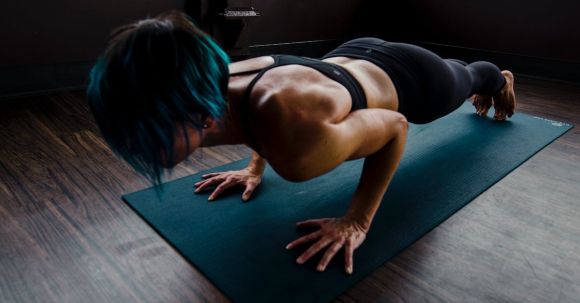Enhancing your yoga practice is not just about mastering challenging poses or increasing flexibility. It is also about cultivating a deeper connection between your mind, body, and breath. Breathwork, also known as pranayama, is a powerful tool that can take your yoga practice to the next level. By incorporating specific breathing techniques into your practice, you can enhance your focus, increase your energy levels, and promote relaxation. In this article, we will explore how to use breathwork to enhance your yoga practice.
Author: fit-on
Are you tired of your usual workout routine? Do you want to burn calories while having fun? Look no further than the Fit on Kickboxing Challenge! Kickboxing is an intense full-body workout that combines martial arts techniques with high-intensity cardio. In this article, we will explore the benefits of kickboxing and how the Fit on Kickboxing Challenge can help you achieve your fitness goals.
Kickboxing: The Ultimate Fat-Burning Workout
Kickboxing is a high-energy workout that engages all major muscle groups, making it an excellent way to burn calories and tone your body. Unlike traditional cardio exercises like running or cycling, kickboxing involves constant movement and incorporates both aerobic and anaerobic exercises. This combination not only helps you burn calories during the workout but also keeps your metabolism elevated long after you're done.Build Strength and Endurance
Kickboxing is not just about burning calories; it also helps you build strength and endurance. The various punches, kicks, and knee strikes used in kickboxing engage your core, arms, legs, and glutes, helping to tone and sculpt your muscles. Additionally, the fast-paced nature of the workout improves your cardiovascular fitness, increasing your stamina and endurance over time.The Fit on Kickboxing Challenge: What to Expect
The Fit on Kickboxing Challenge is a structured program designed to help you achieve your fitness goals through kickboxing. Whether you're a beginner or an experienced kickboxer, this challenge is tailored to your skill level. Here's what you can expect from the Fit on Kickboxing Challenge: 1. Full-Body Workouts: The challenge includes a series of kickboxing workouts that target all major muscle groups. Each workout is carefully designed to maximize calorie burn and improve overall fitness. 2. Expert Guidance: The Fit on Kickboxing Challenge is led by experienced kickboxing instructors who will guide you through each workout. They will teach you proper technique, ensuring you get the most out of every kick, punch, and knee strike. 3. Progression and Variety: As you progress through the challenge, the workouts become more challenging, helping you push your limits and achieve new fitness milestones. The challenge also incorporates a variety of exercises, keeping you engaged and motivated throughout. 4. Community Support: The Fit on Kickboxing Challenge provides a supportive community of like-minded individuals who are also on their fitness journey. You can connect with others, share your progress, and motivate each other to stay on track.Take the Fit on Kickboxing Challenge Today
If you're ready to take your fitness to the next level, the Fit on Kickboxing Challenge is the perfect opportunity. Not only will you blast calories and build strength, but you'll also have a blast doing it. So, put on your gloves, get ready to sweat, and join the Fit on Kickboxing Challenge today! In conclusion, kickboxing is an effective and enjoyable way to burn calories, build strength, and improve endurance. The Fit on Kickboxing Challenge takes it a step further by providing a structured program that caters to individuals of all fitness levels. So, if you're looking for a fun and challenging workout that yields results, don't hesitate to take the Fit on Kickboxing Challenge. Your body will thank you!
Regular exercise is essential for maintaining good cardiovascular health and reducing the risk of heart disease. Engaging in cardiovascular exercises can improve heart function, lower blood pressure, reduce cholesterol levels, and promote overall well-being. In this article, we will explore the benefits of cardiovascular exercises and provide some effective exercises to incorporate into your fitness routine.
Understanding Heart Disease
Heart disease refers to a range of conditions that affect the heart's structure and function. The most common type of heart disease is coronary artery disease, which occurs when the arteries that supply blood to the heart become narrowed or blocked by plaque buildup. This can lead to chest pain, shortness of breath, and even heart attacks.The Importance of Cardiovascular Exercise
Cardiovascular exercise, also known as aerobic exercise, is any activity that increases your heart and breathing rates. It works by strengthening the heart muscle, improving circulation, and increasing the efficiency of oxygen delivery to the body's tissues. Regular cardiovascular exercise can help reduce the risk of heart disease by improving heart health and reducing the factors that contribute to its development.Effective Cardiovascular Exercises
1. Walking: Walking is a low-impact exercise that can be done anywhere, making it an excellent choice for individuals of all fitness levels. Aim for at least 30 minutes of brisk walking most days of the week to reap the cardiovascular benefits. 2. Running: Running is a high-intensity cardiovascular exercise that can help improve cardiovascular fitness and burn calories. Start with shorter distances and gradually increase your speed and distance over time. 3. Cycling: Cycling is a great way to get your heart pumping while also enjoying the outdoors. Whether you prefer cycling on a stationary bike or exploring new paths on a bicycle, it is an effective cardiovascular exercise that targets the lower body muscles. 4. Swimming: Swimming is a low-impact exercise that provides a full-body workout. It is particularly beneficial for individuals with joint pain or injuries. Try swimming laps or participating in water aerobics classes to improve cardiovascular fitness. 5. Jumping Rope: Jumping rope is a fun and effective cardiovascular exercise that can be done almost anywhere. It not only improves heart health but also helps strengthen the muscles in your legs and core. Start with short intervals and gradually increase the duration as your fitness level improves.Tips for a Successful Cardiovascular Exercise Routine
- Start slow: If you are new to exercise or have been inactive for a while, start with shorter durations and lower intensities. Gradually increase the duration and intensity of your workouts to avoid injury. - Mix it up: Incorporate a variety of cardiovascular exercises into your routine to keep it interesting and target different muscle groups. This will also prevent boredom and help you stay motivated. - Listen to your body: Pay attention to how your body feels during and after exercise. If you experience pain or discomfort, modify or stop the activity. It is important to find a balance between pushing yourself and listening to your body's limits. In conclusion, cardiovascular exercises are crucial for reducing the risk of heart disease. By incorporating activities like walking, running, cycling, swimming, and jumping rope into your routine, you can improve heart health, lower blood pressure, and reduce the risk factors associated with heart disease. Remember to start slowly, vary your exercises, and listen to your body to create a successful and enjoyable cardiovascular exercise routine.
Losing weight and achieving a fit and healthy body is a goal for many people. However, with so many weight loss programs available, it can be overwhelming to choose the right one. Fit on Weight Loss Programs offer a comprehensive and effective approach to help you build a better body. Let's explore how these programs can transform your health and fitness.
Understanding Your Body's Needs
One of the key aspects of Fit on Weight Loss Programs is their focus on understanding your body's unique needs. Each person is different, and what works for one may not work for another. These programs take into account your body composition, metabolism, and lifestyle to create a personalized plan that suits you best.Motivation and Accountability
Staying motivated throughout your weight loss journey can be challenging, but Fit on Weight Loss Programs offer the support you need. With a team of dedicated professionals, you will receive guidance and encouragement to keep you on track. Regular check-ins and progress tracking are essential to help you stay accountable and motivated.Balanced Nutrition
A crucial component of any successful weight loss program is a balanced and nutritious diet. Fit on Weight Loss Programs emphasize the importance of eating whole, unprocessed foods that provide essential nutrients. By focusing on nourishing your body with the right foods, you will not only lose weight but also improve your overall health.Effective Exercise Routines
Exercise is a fundamental part of building a better body, and Fit on Weight Loss Programs incorporate effective workout routines. These programs include a variety of exercises, such as strength training, cardio, and flexibility exercises, to help you burn fat, build muscle, and increase your fitness level. The workouts are designed to be challenging yet manageable, ensuring you get the most out of your exercise sessions.Lifestyle Changes
A sustainable weight loss journey involves making lasting lifestyle changes. Fit on Weight Loss Programs provide guidance on adopting healthy habits that you can maintain long-term. These programs focus on behavior modification, helping you develop a positive relationship with food and exercise. By making gradual and sustainable changes, you can achieve lasting results and maintain a fit and healthy body.Supportive Community
Building a better body is not a journey you have to embark on alone. Fit on Weight Loss Programs offer a supportive community of like-minded individuals who are also working towards their fitness goals. This community provides a platform for sharing experiences, seeking advice, and celebrating achievements. Surrounding yourself with a supportive network can significantly increase your chances of success.Stress Management
Stress can often hinder weight loss progress, but Fit on Weight Loss Programs address this important aspect of overall health. These programs provide strategies and techniques for managing stress, such as mindfulness exercises and relaxation techniques. By incorporating stress management into your weight loss journey, you will be better equipped to overcome obstacles and stay focused on your goals.Building a Better Body for Life
Fit on Weight Loss Programs go beyond short-term weight loss goals. They provide a holistic approach to help you build a better body for life. By focusing on understanding your body's needs, staying motivated and accountable, adopting a balanced nutrition plan, incorporating effective exercise routines, making lasting lifestyle changes, and managing stress, you can achieve and maintain a fit and healthy body. In conclusion, Fit on Weight Loss Programs offer a comprehensive and effective approach to help you build a better body. By addressing the various aspects of weight loss, these programs provide personalized plans, support, and guidance to help you achieve lasting results. If you're ready to transform your health and fitness, consider joining a Fit on Weight Loss Program and embark on a journey to a healthier and happier you.
In today's fast-paced world, finding time to go to the gym or attend fitness classes can be a challenge. However, with the convenience of technology and a little creativity, you can achieve your fitness goals right from the comfort of your own home. Here are some effective ways to stay fit and active without leaving your house.
1. Create a Home Gym
One of the best ways to stay motivated and committed to your fitness goals is by setting up a dedicated space for exercise in your home. Designate a room or even a small area where you can keep your fitness equipment and workout gear. This will not only save you time but also make it easier to stick to your routine.2. Follow Online Workouts
Thanks to the rise of online fitness platforms, you can access a wide variety of workout routines and classes from the comfort of your home. Whether you prefer yoga, HIIT, or dance workouts, there is something for everyone. Find a reputable website or app that offers live or pre-recorded workouts and follow along at your own pace.3. Invest in Home Workout Equipment
If you're serious about achieving your fitness goals, consider investing in some home workout equipment. While you don't need a fully equipped gym, having a few key pieces can greatly enhance your workouts. Items like dumbbells, resistance bands, and a stability ball can provide a challenging and effective workout right from your living room.4. Take Advantage of Bodyweight Exercises
Don't underestimate the power of bodyweight exercises. Push-ups, squats, lunges, and planks can all be done without any equipment and are highly effective in building strength and endurance. Incorporate these exercises into your routine to target different muscle groups and achieve a full-body workout.5. Get Creative with Household Items
If you don't have access to workout equipment, don't worry. Look around your house for everyday items that can double as exercise tools. For example, use a chair for tricep dips, a staircase for step-ups, or filled water bottles as makeshift weights. The possibilities are endless when you think outside the box.6. Set Realistic Goals
Setting realistic goals is crucial for staying motivated and focused on your fitness journey. Be specific about what you want to achieve and break it down into smaller, achievable milestones. Celebrate each small victory along the way, and don't forget to adjust your goals as you progress.7. Stay Consistent and Create a Routine
Consistency is key when it comes to achieving your fitness goals. Create a workout schedule that fits into your daily routine and stick to it. Treat your workouts like any other important appointment and prioritize them. By making exercise a habit, you'll be more likely to stay on track and see results.8. Stay Accountable
Finding an accountability partner or joining an online fitness community can greatly enhance your motivation and commitment. Share your goals and progress with others who have similar aspirations, and encourage each other along the way. Having someone to answer to and cheer you on can make a significant difference in achieving your fitness goals. In conclusion, achieving your fitness goals from home is not only possible but also convenient. With the right mindset, resources, and dedication, you can create an effective workout routine in the comfort of your own home. Whether you choose to invest in home workout equipment, follow online workouts, or get creative with household items, the key is to stay consistent and motivated. So, lace up your sneakers, put on your workout gear, and get ready to achieve your fitness goals without leaving your house.
When it comes to working out, there are countless options to choose from. From free weights to machines, the choices can be overwhelming. One often overlooked piece of equipment that can provide numerous benefits is the resistance band. These stretchy bands may seem simple, but they can add a whole new level of intensity to your workouts. In this article, we will explore the many benefits of incorporating resistance bands into your fitness routine.
Versatility and Portability
One of the greatest advantages of resistance bands is their versatility. They can be used in a wide variety of exercises to target different muscle groups. Whether you're looking to tone your arms, strengthen your legs, or work on your core, resistance bands can be easily adapted to suit your needs. Additionally, resistance bands are lightweight and portable, making them perfect for traveling or for those who prefer to work out at home. You can easily throw them in your bag and take them with you wherever you go.Improved Muscle Strength and Tone
Resistance bands provide a unique form of resistance that can help improve muscle strength and tone. Unlike traditional weights, which rely on gravity, resistance bands create resistance through tension. This constant tension engages your muscles throughout the entire range of motion, resulting in improved strength and muscle definition. Whether you are a beginner or an advanced athlete, resistance bands can help you take your workouts to the next level.Joint-Friendly Workouts
For those with joint issues or injuries, resistance bands offer a low-impact alternative to traditional weights. The elastic nature of the bands puts less stress on your joints, making them a safer option for those with arthritis or other joint conditions. The controlled resistance provided by the bands also helps improve joint stability and mobility, reducing the risk of injury.Increased Flexibility and Range of Motion
Incorporating resistance bands into your workouts can also help improve flexibility and range of motion. The stretching and pulling motions required when using resistance bands help lengthen and strengthen your muscles, increasing your overall flexibility. This increased flexibility can help prevent injuries and improve your performance in other activities, such as running or yoga.Enhanced Core Stability
Resistance bands are excellent tools for targeting your core muscles. The instability created by the bands forces your core muscles to work harder to maintain balance and stability. This not only helps strengthen your abs, but it also engages your back, hips, and glutes, resulting in improved overall core strength and stability.Affordability
Another advantage of resistance bands is their affordability. Compared to other gym equipment, resistance bands are relatively inexpensive and can often be purchased in sets of varying resistance levels. This makes them a cost-effective option for those on a tight budget or for those who prefer to work out at home. In conclusion, resistance bands are a versatile and portable tool that can provide numerous benefits for your workouts. From improved muscle strength and tone to increased flexibility and core stability, resistance bands offer a unique form of resistance that can take your fitness routine to the next level. Whether you're a beginner or an advanced athlete, incorporating resistance bands into your workouts can help you achieve your fitness goals. So why not give them a try and experience the benefits for yourself?
Setting goals is an essential aspect of personal growth and development. Whether you want to lose weight, advance in your career, or learn a new skill, having a clear goal can provide direction and motivation. However, achieving these goals is not always easy. It requires commitment, perseverance, and the willingness to face challenges head-on. In this article, we will explore how you can crush your goals by fitting on challenges that are suitable for every level.
Identify Your Goals
The first step in crushing your goals is to identify what you want to achieve. Take some time to reflect on your aspirations and write them down. Be specific about what you want to accomplish and set a deadline for each goal. This will help you stay focused and motivated throughout the process.Start with Small Challenges
Once you have identified your goals, it can be tempting to dive straight into the deep end. However, starting with small challenges is a more effective approach. Break down your goals into smaller, manageable tasks that you can accomplish in a shorter period. This will not only make the process less overwhelming but also give you a sense of progress and accomplishment along the way.Push Your Comfort Zone
To crush your goals, you need to embrace challenges that push you outside of your comfort zone. Stepping outside of what is familiar and comfortable can be intimidating, but it is where true growth happens. Pushing your limits will enable you to develop new skills, gain confidence, and overcome obstacles that might have seemed insurmountable before.Embrace Failure as a Learning Opportunity
Failure is a natural part of the journey towards achieving your goals. Instead of viewing it as a setback, embrace failure as a valuable learning opportunity. Take the time to reflect on what went wrong, identify the lessons learned, and adjust your approach accordingly. Remember that every failure brings you one step closer to success.Surround Yourself with Supportive People
Having a strong support system can make a significant difference in your ability to crush your goals. Surround yourself with people who believe in you, encourage you, and hold you accountable. Seek out mentors or join communities of like-minded individuals who are also striving to achieve their goals. Their support and guidance can provide the motivation and inspiration you need to stay on track.Stay Consistent and Persistent
Consistency and persistence are key when it comes to crushing your goals. It is important to stay committed and dedicated to the process, even when faced with obstacles or setbacks. Set a routine that allows you to work towards your goals consistently, and be persistent in your efforts, even when progress seems slow. Remember that success is the result of consistent, focused action over time.Celebrate Milestones
As you make progress towards your goals, it is crucial to celebrate your milestones along the way. Recognize and reward yourself for the hard work and effort you have put in. This will not only boost your motivation but also serve as a reminder of how far you have come. Celebrating milestones helps to maintain enthusiasm and momentum as you move closer to achieving your ultimate goal. In conclusion, crushing your goals is not an easy task, but it is possible with the right mindset and approach. By identifying your goals, starting with small challenges, pushing your comfort zone, embracing failure, surrounding yourself with supportive people, staying consistent and persistent, and celebrating milestones, you can overcome any challenge that comes your way. So, go out there and crush your goals!
Carbohydrates, commonly known as carbs, have long been a topic of debate when it comes to their impact on our health. With so much conflicting information out there, it can be challenging to separate fact from fiction. In this article, we will delve into the truth about carbs and provide you with the knowledge you need to make informed decisions about your diet.
The Basics of Carbohydrates
Before we dive into the details, let's start with the basics. Carbohydrates are one of the three macronutrients, along with protein and fat, that our bodies need to function properly. They are our primary source of energy and are found in a wide variety of foods, including grains, fruits, vegetables, and dairy products.Types of Carbohydrates
Not all carbs are created equal. There are three main types of carbohydrates: sugars, starches, and fiber. Sugars, such as those found in candy and soda, are simple carbohydrates that provide a quick burst of energy but lack nutritional value. Starches, found in foods like bread, pasta, and rice, are complex carbohydrates that take longer to break down and provide sustained energy. Fiber, found in foods like whole grains, fruits, and vegetables, is a type of carbohydrate that cannot be fully digested by the body but plays a crucial role in digestive health.The Role of Carbs in a Healthy Diet
Carbohydrates are an essential part of a healthy diet, despite what some fad diets may have you believe. They provide us with the energy we need to fuel our daily activities, support brain function, and maintain overall well-being. However, the key is to choose the right types of carbs and consume them in moderation.The Importance of Whole Grains
Whole grains, such as brown rice, quinoa, and whole wheat bread, are an excellent choice when it comes to carbs. Unlike refined grains, which have been stripped of their fiber and nutrients, whole grains retain their nutritional value, providing us with essential vitamins, minerals, and dietary fiber. They also help regulate blood sugar levels and promote a feeling of fullness, making them an excellent option for weight management.The Impact of Added Sugars
While natural sugars, such as those found in fruits, are part of a healthy diet, added sugars are a different story. Added sugars, which are often found in processed foods and beverages, provide empty calories and can contribute to weight gain, heart disease, and other health issues. It's important to read food labels carefully and limit your intake of added sugars as much as possible.Balancing Carbs with Protein and Fat
While carbs are an essential part of our diet, it's crucial to consume them in conjunction with protein and fat. Including protein-rich foods, such as lean meats, fish, beans, and nuts, helps stabilize blood sugar levels and promotes muscle growth and repair. Healthy fats, like those found in avocados, olive oil, and nuts, are also important for overall health and can help promote satiety.Making Informed Choices
In conclusion, carbohydrates are not the enemy when it comes to our health. It's the quality and quantity of carbs that matter. Opting for whole grains, fruits, and vegetables while limiting added sugars is the key to a balanced diet. Remember to pair your carbs with protein and healthy fats for optimal nutrition. By understanding the truth about carbs, you can make informed choices and achieve a healthier lifestyle.
When it comes to cardio workouts, it's important to constantly challenge yourself in order to see progress and improvement. Whether you're a beginner or a seasoned fitness enthusiast, there are several strategies you can implement to take your cardio workouts to the next level. In this article, we will explore some effective ways to progress in your cardio workouts for continuous improvement.
Vary Your Intensity
One of the most effective ways to progress in your cardio workouts is by varying your intensity. Instead of sticking to the same pace throughout your workout, try incorporating high-intensity intervals. This can be done by alternating between periods of intense effort and active recovery. Not only does this challenge your cardiovascular system, but it also helps to burn more calories and improve your overall fitness level.Increase Your Duration
Another way to progress in your cardio workouts is by gradually increasing your workout duration. Start by adding a few minutes to your workout each week, and over time, aim to reach a longer duration. This not only helps to build your endurance but also ensures that you are constantly pushing your limits and challenging your body. Remember to listen to your body and gradually increase the duration to avoid overexertion and injury.Incorporate Different Types of Cardio
To keep your workouts interesting and avoid hitting a plateau, it's important to incorporate different types of cardio exercises. This could include activities such as running, cycling, swimming, or even dancing. By switching up your exercises, you engage different muscle groups and prevent your body from adapting to a specific routine. This not only helps to improve your overall fitness level but also keeps you motivated and excited about your workouts.Add Resistance Training
While cardio workouts primarily focus on improving your cardiovascular endurance, adding resistance training to your routine can help take your workouts to the next level. Incorporating exercises such as weightlifting or using resistance bands can help build strength and muscle, which in turn enhances your overall performance during cardio exercises. By combining cardio and resistance training, you create a well-rounded workout routine that targets different aspects of fitness.Track Your Progress
In order to measure your progress and keep yourself motivated, it's important to track your workouts. This can be done through various methods such as using a fitness tracker, keeping a workout journal, or using smartphone apps. By monitoring your workouts, you can see how far you've come and set new goals for continuous improvement. Additionally, tracking your progress allows you to identify any areas that may need further attention and make necessary adjustments to your workout routine.Stay Consistent
Consistency is key when it comes to progressing in your cardio workouts. It's important to establish a regular workout schedule and stick to it. Aim for at least three to five cardio sessions per week, and make it a priority to show up and give your best effort each time. By staying consistent, you create a habit that allows for continuous improvement and ensures that you are making progress towards your fitness goals. In conclusion, progressing in your cardio workouts is essential for continuous improvement. By varying your intensity, increasing your duration, incorporating different types of cardio, adding resistance training, tracking your progress, and staying consistent, you can take your workouts to the next level. Remember to always listen to your body, push your limits, and stay motivated on your fitness journey.
A strong core is essential for overall body strength and stability. It not only helps improve posture and balance but also plays a crucial role in preventing injuries. While many people believe that achieving a strong core requires expensive gym memberships or fancy equipment, the truth is that you can build a solid core right in the comfort of your own home. In this article, we will explore some effective home workouts that can help you develop a strong core without breaking the bank.









